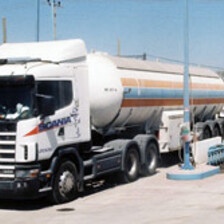The Electronic Intifada 29 January 2009

A map of Gaza showing its border crossings with Israel and Egypt. (Gisha)
“The donors and the general public have mobilized from all over the world but the aid is stuck outside Gaza,” said John Ging, head of the UN agency for Palestine refugees (UNRWA) in Gaza.
Of the 100-120 trucks permitted to enter per day, some 37-40 are for UNRWA, about half are for commercial goods such as meat and diapers, and the remainder are for other aid agencies, said Ging, who pointed out that before June 2007 Israel permitted 500-600 trucks to enter daily.
Food in Gaza is still scarce due to price increases and the lack of currency, and the destruction of farmland is exacerbating food shortages, according to the Office for the Coordination of Humanitarian Affairs (OCHA). Apart from the tunnels from Egypt, there are no other ways of getting food or other goods into Gaza.
There are five crossings into Gaza — four from Israel and one from Egypt. However, none are open in a regular or consistent way, and relatively little aid is getting through.
Nahal Oz
Underground fuel pipeline allowing privately purchased fuel to enter Gaza. EU-funded industrial fuel for Gaza’s sole power plant comes in via Nahal Oz, as does the fuel UNRWA is able to receive.
Karni
Only commercial crossing with the facilities to allow large numbers of trucks to enter Gaza. Closed since June 2007. UN has been calling for it to be reopened. The conveyor belt operates at present for grain deliveries only.
Kerem Shalom
Small commercial crossing. Lacks facilities to allow large numbers of trucks to enter Gaza — hence current bottleneck.
“The trucks that enter via Kerem Shalom are for UN agencies and the private sector,” Hamas official Ghazi Hamad told IRIN by phone. “Fuel, gas and building materials, like cement and glass, and other supplies like clothing, have not entered [from anywhere].”
Erez
Passenger crossing only. Since 2005 this has been the only crossing Israel allows passengers to use — when it is open.
Rafah
Passenger crossing; medical supplies also being allowed through. Other aid from Egypt has to take the Israel-Kerem Shalom-Gaza route.
Tunnels
Fuel and cooking gas supplies are again entering Gaza via tunnels along the Gaza-Egypt border, according to Gaza residents, although at a slower rate because of damage caused by the Israeli bombardments.
The Coordination of Government Activities in the [Occupied Palestinian] Territories (COGAT), which operates under the Israeli Defense Ministry, has said over 5.5 million liters of diesel were approved for transfer (not necessarily delivered) to Gaza for the sole power station between 18-23 January.
Since the ceasefire came into effect on 18 January, the power plant has received about 223,000 liters of diesel per day, but needs 450,000 a day to generate electricity at its full capacity of 80MW. Currently the plant is producing 30MW daily, according to OCHA.
Israel has allowed about 87 tons of gas daily to enter Gaza since 18 January, but OCHA says estimated daily needs are for 300 tons.
This item comes to you via IRIN, a UN humanitarian news and information service, but may not necessarily reflect the views of the United Nations or its agencies. All IRIN material may be reposted or reprinted free-of-charge; refer to the copyright page for conditions of use. IRIN is a project of the UN Office for the Coordination of Humanitarian Affairs.
Related Links


